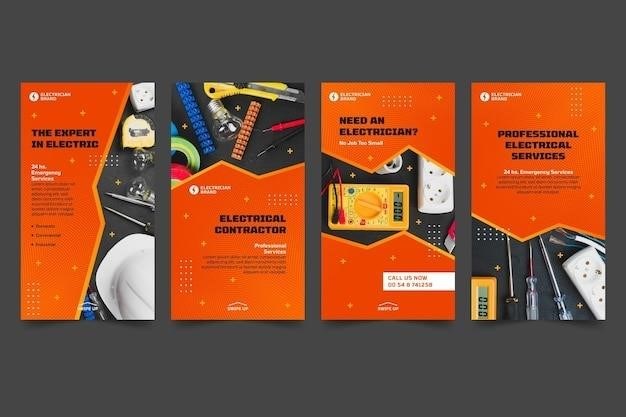Vivint Thermostat User Manual⁚ A Comprehensive Guide
This comprehensive guide will walk you through the ins and outs of using your Vivint Thermostat; From installation and setup to advanced features and troubleshooting, we’ve got you covered. Learn how to connect your thermostat to your Vivint system, navigate the user interface, and leverage its smart features to optimize your home’s comfort and energy efficiency. We’ll also explore common issues and provide helpful solutions to keep your thermostat running smoothly.
Introduction
Welcome to the world of smart home comfort with the Vivint Thermostat! This innovative device is designed to seamlessly integrate with your Vivint Smart Home system, empowering you to take control of your home’s temperature like never before. With its intuitive interface, advanced features, and user-friendly design, the Vivint Thermostat provides a convenient and efficient way to manage your home’s climate; This manual will serve as your comprehensive guide, equipping you with the knowledge and tools to maximize the potential of your Vivint Thermostat, ensuring a comfortable and energy-efficient living experience.
Getting Started⁚ Installation and Setup
Before you can start enjoying the benefits of your Vivint Thermostat, you need to install and set it up. This section will guide you through the process, providing detailed instructions and helpful tips to ensure a smooth installation. We’ll cover everything from connecting your thermostat to your Vivint system to wiring and power supply, as well as adding the thermostat to your Z-Wave network. With these steps completed, you’ll be ready to take full advantage of the advanced features and capabilities of your Vivint Thermostat.
Connecting to the Vivint System
Integrating your Vivint Thermostat with your existing Vivint Smart Home system is crucial to unlocking its full potential. This connection allows you to control your thermostat remotely using the Vivint app, voice commands, and even automation rules. To connect your thermostat, you’ll need to follow a simple inclusion process, which involves putting your Vivint panel into “add node” mode and then initiating the pairing process on the thermostat itself; Once successfully connected, your thermostat will appear in your Vivint app, granting you complete control over your home’s temperature settings from anywhere.
Wiring and Power Supply
Proper wiring and power supply are essential for the smooth operation of your Vivint Thermostat. The thermostat can be powered in two ways⁚ through a C-wire connection to your HVAC system or by using AA batteries. If your HVAC system has a C-wire, connecting it to the thermostat provides a constant power source, eliminating the need for battery replacements. However, if a C-wire is unavailable, you can rely on batteries, but you’ll need to ensure they are replaced periodically. The wiring process itself involves connecting wires from your HVAC system to the corresponding terminals on the thermostat. It’s recommended to consult the Vivint installation guide for detailed diagrams and instructions specific to your model. Proper wiring ensures seamless communication between the thermostat and your HVAC system, allowing for accurate temperature control and efficient operation.
Adding the Thermostat to Your Z-Wave Network
Integrating your Vivint Thermostat into your Z-Wave network allows for seamless communication between the thermostat and your Vivint Smart Home system. This integration enables you to control your thermostat from anywhere using the Vivint app or a voice assistant. Adding the thermostat to your Z-Wave network is typically a straightforward process. Firstly, your Vivint panel needs to be set to “add node” mode. This allows the panel to recognize and accept the thermostat as a new device on the network. Next, you’ll initiate the pairing process on the thermostat itself, usually by pressing a designated button. The thermostat will then communicate with the panel, establishing a connection. Once the connection is established, the thermostat will be recognized as a part of your Z-Wave network, granting you complete control and integration with your Vivint Smart Home system.
Understanding Your Thermostat
The Vivint Thermostat boasts a user-friendly interface, designed to make controlling your home’s temperature a breeze. The thermostat’s touchscreen display is intuitive and responsive, allowing you to easily navigate through menus and adjust settings. You’ll find a variety of features at your fingertips, including temperature control, scheduling, and even humidity management. The thermostat’s main screen typically displays the current temperature, the selected mode (heating, cooling, or off), and the set temperature. From here, you can make quick adjustments by tapping on the temperature display or accessing the settings menu for more in-depth customization. Whether you prefer to manage your thermostat directly on the device itself or through the convenience of the Vivint app, the thermostat’s intuitive design ensures a seamless user experience.
Basic Features and Functions
At its core, the Vivint Thermostat provides essential temperature control functionality. You can easily set your desired temperature for both heating and cooling, ensuring your home stays comfortable throughout the day. The thermostat offers various operating modes, including “Heat,” “Cool,” “Auto,” and “Off.” The “Auto” mode automatically switches between heating and cooling based on your set temperature range. The “Fan” setting allows you to circulate air without engaging the heating or cooling system. Additionally, the thermostat features a “Hold” function, enabling you to temporarily override your scheduled settings for a specific period. These basic features provide the foundation for creating a comfortable and energy-efficient environment in your home.
Navigating the Thermostat Interface

The Vivint Thermostat boasts a user-friendly interface designed for ease of navigation. The main screen prominently displays the current temperature and allows you to adjust it with simple touch controls. The interface also presents a clear view of your selected mode, whether it’s heating, cooling, or auto. You can access additional settings and features by tapping on icons or navigating through menus. For instance, you can access scheduling options, view energy usage data, and adjust humidity levels. The thermostat’s intuitive interface makes it easy to customize your settings and control your home’s climate with precision. Whether you prefer a visual approach or a more hands-on method, the Vivint Thermostat offers a smooth and convenient user experience.

Temperature Control
The Vivint Thermostat empowers you to take complete control of your home’s temperature. You can easily adjust the desired temperature using the thermostat’s touch screen interface. The thermostat allows you to set your desired temperature in either Fahrenheit or Celsius. You can also switch between different modes, such as heating, cooling, or auto, to ensure optimal comfort. The thermostat’s responsive controls and clear display provide instant feedback, allowing you to fine-tune the temperature to your liking. Whether you want to warm up the house on a chilly day or cool down on a sweltering summer afternoon, the Vivint Thermostat gives you the power to create the perfect environment for your home.
Advanced Features
The Vivint Thermostat offers a suite of advanced features that go beyond basic temperature control. These features enhance comfort, efficiency, and convenience, making your home smarter and more responsive to your needs. You can customize the thermostat’s behavior to suit your preferences and lifestyle. The thermostat’s humidity control feature allows you to maintain optimal humidity levels, creating a more comfortable and healthy environment. Programmable schedules let you set different temperatures for different times of day, ensuring your home is always at the right temperature, whether you’re at home or away. The Vivint Thermostat seamlessly integrates with the Vivint Smart Home System, enabling you to control your thermostat remotely from your smartphone or voice assistant. These advanced features empower you to take your home’s comfort and energy efficiency to the next level.
Humidity Control
The Vivint Thermostat goes beyond just regulating temperature; it also manages humidity levels in your home. This feature is particularly valuable in areas prone to extreme humidity, where maintaining comfortable indoor conditions can be challenging. The thermostat’s built-in humidity sensor constantly monitors moisture levels, allowing you to set a desired range for optimal comfort. You can adjust the humidity setting using the thermostat’s interface, the Vivint app, or voice commands. By controlling humidity, you can create a more comfortable environment, reduce the risk of mold growth, and potentially improve the performance of your HVAC system. The Vivint Thermostat’s humidity control feature empowers you to create a healthier and more comfortable home environment.
Scheduling and Automation
The Vivint Thermostat empowers you to take control of your home’s temperature with its robust scheduling and automation features. Create custom schedules to automatically adjust your thermostat settings throughout the day, week, or even year. For example, you can set a schedule to lower the temperature at night while you sleep, or to raise it in the morning before you wake up. This allows you to optimize comfort and energy efficiency while maintaining your desired temperature levels. The thermostat’s automation features also enable you to set up specific temperature adjustments based on your location or other factors. This could include automatically adjusting the temperature when you leave home or when you’re about to arrive. With its intuitive scheduling and automation capabilities, the Vivint Thermostat offers a personalized and convenient way to manage your home’s temperature, saving you time and energy while maximizing comfort.
Integration with Vivint Smart Home System
The Vivint Thermostat seamlessly integrates with the Vivint Smart Home system, providing a unified platform for controlling and managing your entire home environment. This integration allows you to leverage the power of your Vivint system to enhance the functionality and convenience of your thermostat. For instance, you can create custom automation rules that trigger temperature adjustments based on the status of other connected devices, such as door and window sensors. Imagine automatically lowering the temperature when you leave home or raising it when you’re about to arrive, ensuring optimal comfort and energy efficiency. Furthermore, the Vivint Thermostat’s integration with your Vivint system offers a centralized control hub, enabling you to manage your thermostat alongside other smart home devices like security cameras, door locks, and lighting. This comprehensive approach delivers a truly connected and intelligent home environment that simplifies your life and elevates your control over your home’s comfort and security.
Troubleshooting and Support
While Vivint thermostats are designed for reliability, occasional issues can arise. If you encounter a problem with your thermostat, start by reviewing the Vivint support website or the user manual for common troubleshooting tips. These resources often provide solutions for issues like connectivity problems, inaccurate temperature readings, or malfunctioning features. If you’re unable to resolve the issue yourself, Vivint offers various support channels to assist you. You can contact Vivint support directly via phone, email, or online chat. Their dedicated team of experts is available to provide personalized guidance and technical assistance. Be prepared to describe the issue you’re experiencing, the model of your thermostat, and any troubleshooting steps you’ve already attempted. Vivint is committed to ensuring your satisfaction and providing timely solutions to keep your thermostat working flawlessly.
Common Issues and Solutions
While Vivint thermostats are designed for reliability, occasional issues can arise. Here are some common problems and their solutions⁚
- Connectivity Issues⁚ If your thermostat is not connecting to your Wi-Fi network, ensure your router is turned on and your internet connection is stable. Try restarting your thermostat and router. Check your Wi-Fi password for accuracy.
- Inaccurate Temperature Readings⁚ If the temperature displayed on the thermostat seems off, check that the thermostat is positioned in a central location away from drafts or direct sunlight. Consider calibrating the thermostat according to the instructions in your user manual.
- Battery Issues⁚ If the thermostat’s battery is low, replace it with fresh batteries. If the thermostat is powered by a C-wire, ensure the wire is properly connected to the HVAC system.
- HVAC System Malfunction⁚ If the thermostat is not controlling the HVAC system, check the circuit breaker for the system. Ensure the HVAC system is running and that the filters are clean.
If these solutions don’t resolve the issue, contact Vivint support for further assistance.



























